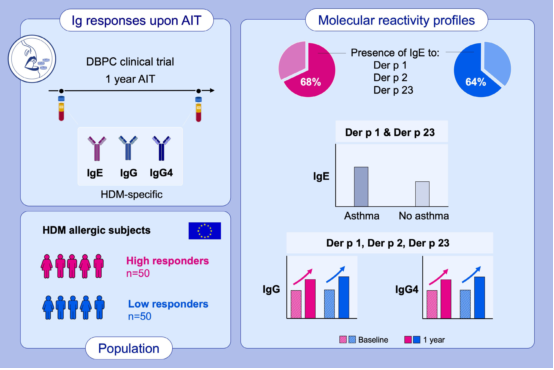Release date:2023-02-05

Allergy
[IF:13.146]
Molecular reactivity profiling upon immunotherapy with a 300 IR sublingual house dust mite tablet reveals marked humoral changes towards major allergensDOI: 10.1111/all.15327
Abstract:
Background: Molecular antibody reactivity profiles have not yet been studied in depth in patients treated by sublingual house dust mite (HDM) tablet immunotherapy. Humoral immune responses to a large panel of HDM mite allergens were studied using allergen microarray technology in a subset of clinically defined high and low responder patients from a double-blind placebo-controlled allergen-specific immunotherapy (AIT) trial using sublingual 300 IR HDM tablets.
Methods: : Serum levels of IgE, IgG and IgG4 to 13 Dermatophagoides pteronyssinus molecules were measured at baseline and after 1-year AIT, using allergen microarrays in 100 subjects exhibiting high or low clinical benefit.
Results: Der p 1, Der p 2 and Der p 23 were the most frequently recognized allergens in the study population. Patients with HDM-related asthma had significantly higher allergen-specific IgE levels to Der p 1 and Der p 23. No significant difference in the distribution of allergen sensitization pattern was observed between high and low responders. An increase in serum allergen-specific IgG and IgG4 occurred upon AIT, in particular to allergens Der p 1, Der p 2 and Der p 23 (p < 0.0001).
Conclusion: We confirm for our study population that Der p 1-and Der p 23-specific IgE levels are associated with asthma. IgE reactivity profiles were not predicitive of sublingual AIT outcomes, with 300 IR tablets as efficacious in pauci-and multi-sensitized subjects. Our study is the first to demonstrate the induction of IgG and IgG4 specific for the HDM allergens Der p 1, Der p 2 and Der p 23 by sublingual AIT.
First Author:
Ekaterina Potapova
Correspondence:
Laurent Mascarell, Innovation & Science Department, Stallergenes SAS, Antony, France.
2023-02-01 Article
 杭州浙大迪迅生物基因工程有限公司
杭州浙大迪迅生物基因工程有限公司
